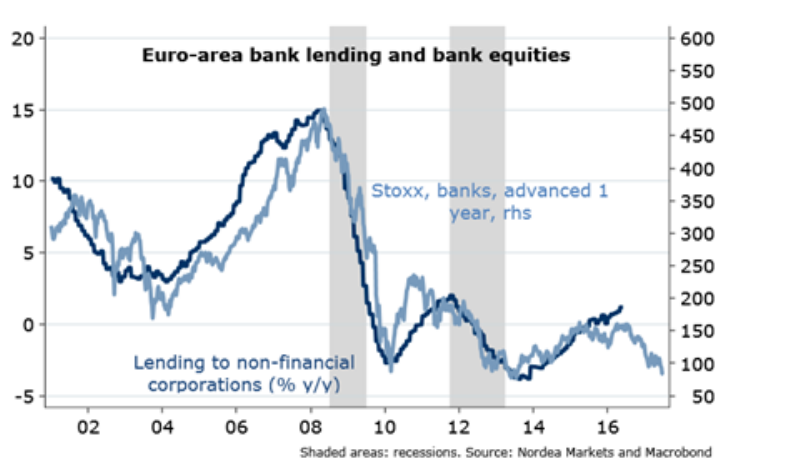GBP/EUR Near Top of Range Following Employment Data; ECB meeting on Thursday and UK PMI's on Friday
The GBP/EUR pair rose to the top of its current sideways range on Wednesday after the release of positive UK jobs data gave it a lift. The European Central Bank rate meeting on Thursday and UK July PMI’s on Friday are the highlights of the week ahead for this pair

The pound to euro rate temporarily rose to just shy of 1.2000 on Wednesday after Employment data showed the jobs market in fine fettle.
The data showed UK unemployment rate fell to an 11-year low of 4.9% in the three months to May 2016, and the economy added 176k jobs in that time.
Average Weekly Earnings rose by 2.3% in line with expectations, from 2.0% previously, although Weekly Earnings not including Bonuses rose by a lower-than-expected 2.2% when a 2.4% rise had been forecast, from 2.3% in the previous three months.
Despite the upbeat data GBP/EUR continues moving in a tight sideways range between 1.21 and 1.18 in the run up to the other two main data events for the week for the pair - the European Central Bank (ECB) rate meeting on Thursday and the release of the first significant post-Brexit data on Friday, in the shape of Manufacturing, Services and Construction PMIs.
Regarding the employment data, Capital Economics' Paul Hollingsworth said he still expected the Bank of England's MPC to go ahead with plans to increase stimulus measures to support the economy in August:
"Despite the relatively upbeat assessment of the labour market, we still expect the MPC to follow through with its (loose) commitment to ease policy at its next meeting on 4th August. After all, the vote to leave the EU will almost certainly now cause some firms to put hiring decisions on hold or cut back headcounts altogether. Indeed, we expect the unemployment rate to begin to drift up over the coming quarters."
What are the charts forecasting?
From a technical perspective, the inverse head and shoulders bottom pattern at the lows - which may or may not be valid in the end - remains in play and could trigger a move higher.
Confirmation of such a break higher would come from a move above the pattern's neckline at 1.2150, which would lead to a probable strong and swift follow-through to 1.2350.
The recent sideways extension over the last few days, however, has brought into question the validity of the inverse H&S and if it fails then the pair is likely to continue going lower, with a break below 1.18 range lows leading to a sell-off down to the 1.16 early July lows.
ECB meeting in top spot
The main event for the euro in the week ahead is the European Central Bank (ECB) interest rate meeting on Thursday July 21.
No change in policy is expected, but analysts, such as Nordea Bank’s Holger Sandte, think that there is a chance the ECB may change its monetary policy ‘settings’’.
The fallout from Brexit has resulted in a larger share of German Bund yields falling below the minimum acceptable level for the ECB to consider buying them, and this now means that the ECB’s bond purchase programme will run out of bonds to buy by the end of the year, instead of Q1 or Q2 of 2017 as previously expected.
There is therefore a possibility the ECB could relax the rules, particularly the rule that it can only buy bonds with yields above the -0.4% deposit rate.
This is unlikely to move the euro spectacularly, however.
What would possibly hit the euro would be early signs Brexit was damaging the Eurozone economy more than expected, however, it is probably too early for Draghi and his team to be able to assess that.
Nevertheless, Sandte, observes that there is a close correlation between bank lending and bank share prices, and so given the extreme sell-off in Eurozone bank shares as a result of Brexit, this could indicate a commensurate fall in lending.
Lack of lending has been a major problem besetting a more rapid recovery in Europe after the financial crisis so a further fall in it would be highly detrimental to the economy of the region:
“The renewed underperformance of bank stocks returned the difficulties of the sector back in focus. In fact, if bank lending follows bank stock prices as traditionally has been the case, the Euro area could be in for a recession (see first chart). So the banking problem needs to be addressed.” Writes Sandte.
Impact of Nice Terrorist Attack?
Following the terrorist attack in Nice, in which 84 people dies, there may be increased support for far right nationalist parties, because of their tough stance on immigration and border control.
If there are signs this is the case that will be another threat to the ‘Euro project’ which would weigh on the single currency.
Italian banks reaching crisis point?
Meanwhile, concerns that Italian Banks may be at crisis point may be a little overdone, according to Erik Nielsen, Global Chief Economist at Italian lender UniCredit, who clarifies several distinctions in a recent note:
“As far as we know, the banks under consideration in Italy are not insolvent. The problem is the capitalization level under stress tests. This may require precautionary recapitalization (this is consistent with Article 32 (4) (d) in Banking Recovery and Resolution Directive (BRRD)).”
UK Data - July PMI's first major post-Brexit release
Data out on Friday includes July Services, Manufacturing and Construction PMI.
These will provide one of the first snapshots of how the economy is managing after Brexit, and will be a highly influential factor in shaping market sentiment.







Jul19.png)




